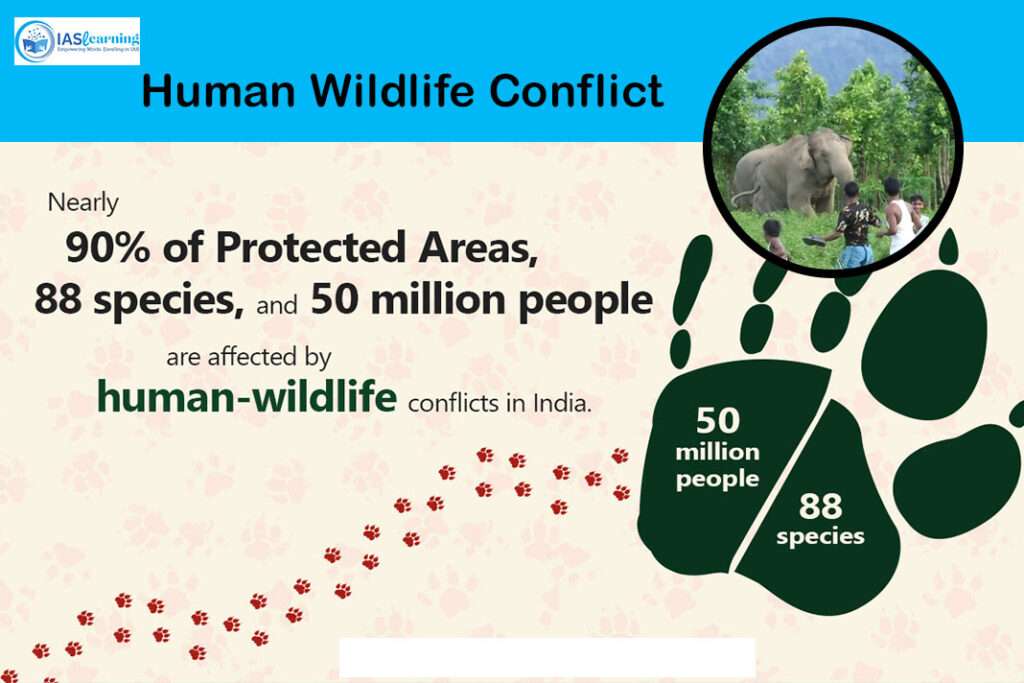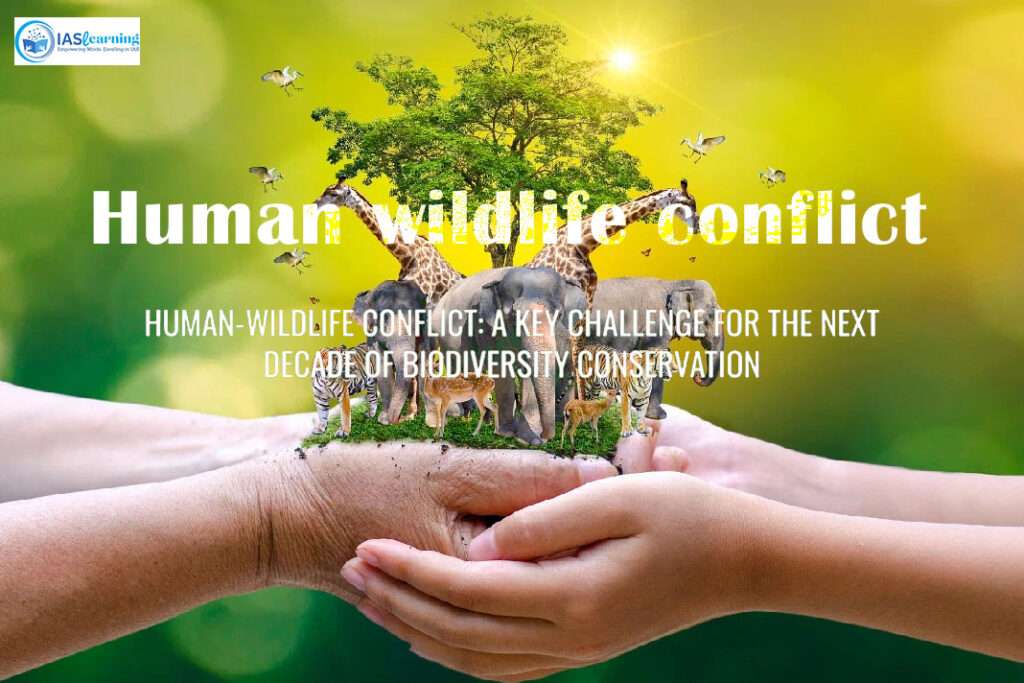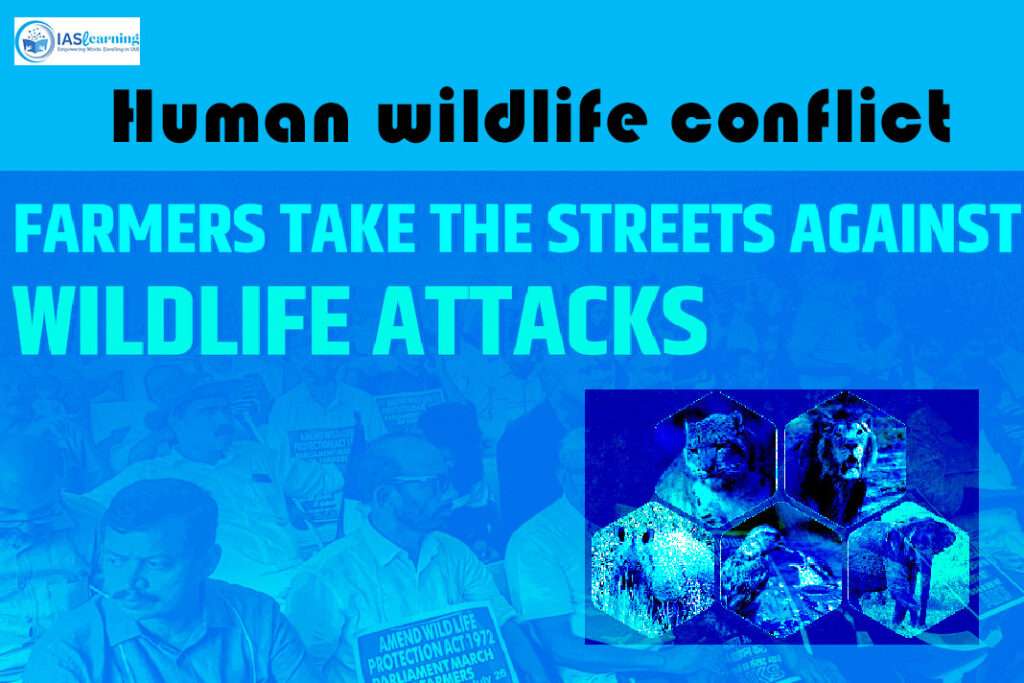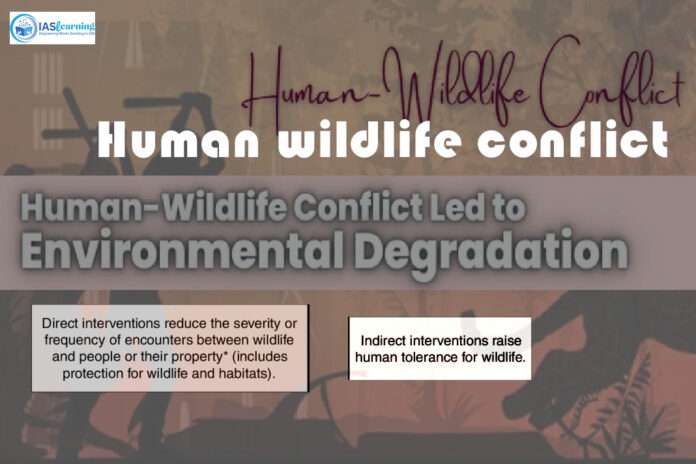Introduction to Human wildlife conflict
Human wildlife conflict is a multifaceted issue that arises when human activities intersect with the natural habitats of wild animals. This collision often leads to negative consequences for both humans and wildlife.
Human wildlife conflict (HWC) is a complex and multifaceted issue that arises when the interests and activities of humans collide with those of wildlife. It occurs in various forms, from crop raiding by elephants in rural India to predators preying on livestock in the American West. As human populations expand and encroach upon natural habitats, the frequency and intensity of these conflicts are on the rise. HWC has significant consequences for both people and wildlife and requires innovative solutions that promote coexistence and conservation.

Human wildlife Conflict
It refers to struggles that arise when the presence or behaviour of wildlife poses actual or perceived direct, recurring threats to human interests or needs, often leading to disagreements between groups of people and negative impacts on people and/or wildlife.
Causes Human wildlife conflict
- Habitat Loss and Fragmentation: As human populations expand, they encroach upon wildlife habitats, leading to habitat loss and fragmentation. This forces animals to venture into human-dominated areas in search of food, water, and shelter.
- Agriculture and Livestock Farming: Wildlife can pose a significant threat to agricultural crops and livestock. Crop depredation by herbivores and predation on livestock by carnivores can result in economic losses for farmers.
- Urbanization: Rapid urbanization leads to the conversion of natural landscapes into urban areas. This creates an environment where humans and wildlife interact closely, often with negative consequences. Urban areas may attract wildlife due to food availability.
- Deforestation: The clearing of forests for timber, agriculture, and infrastructure development disrupts wildlife habitats. Animals are forced to move into new areas, sometimes bringing them into conflict with humans.
- Climate Change: Climate change can alter the distribution of wildlife as they seek more suitable habitats. This can lead to increased interactions with humans as animals move to new areas in search of food and water.
- The loss of animal life and fragmentation of natural habitats are the results of development operations such as building roads and railroads across animal habitats.
- As human populations and space demands rise, people and wildlife are interacting more and vying for the same resources, leading to more human-wildlife conflict.
- As a result of increased flooding, forest fires, and droughts brought on by climate change, animals are now being forced to abandon their natural habitats in search of food and shelter.
- Wild herbivores’ access to food has decreased because of invasive plants like Prosopis juliflora and Lantana camara infesting forests. Herbivores leave the forest to graze on agricultural crops as a result.
- Changing cropping patterns that attract wild animals to farmlands.
- Movement of human beings to forests for illegal collection of forest produce.
Impacts Human wildlife conflict

- Economic Losses: Farmers and communities affected by HWC often suffer significant economic losses, leading to poverty and food insecurity.
- Loss of Life: HWC can result in human injuries and fatalities, particularly in regions with dangerous wildlife.
- Wildlife Decline: Retaliatory killings, habitat destruction, and the capture of animals for illegal trade can lead to declines in wildlife populations.
- Psychological Stress: Living in constant fear of wildlife attacks can result in psychological stress among affected communities.
- Conservation Challenges: HWC complicates wildlife conservation efforts, making it harder to protect and preserve endangered species.
Initiatives Taken to Tackle the Human wildlife conflict
- Advisory for Management of Human Wildlife Conflict (HWC): This has been issued by the Standing Committee of the National Board of Wildlife (SC-NBWL).
- Empower Gram Panchayats: The advisory envisages empowering gram panchayats in dealing with problematic wild animals as per the WildLife (Protection) Act, 1972.
- Provide Insurance: Utilising add-on coverage under the Pradhan Mantri Fasal Bima Yojna for crop compensation against crop damage due to HWC.
- Augmenting Fodder: Envisages augmenting fodder and water sources within the forest areas.
- Take Proactive Measures: Prescribes inter-departmental committees at the local/state level, adoption ofearly warning systems, creation of barriers, dedicated circle-wise Control Rooms with toll-free hotline numbers, Identification of hotspots, etc.
- Provide Instant Relief: Payment of a portion of ex-gratia as interim relief within 24 hours of the incident to the victim/family.
- Standard Operating Procedures: For management of major problematic animals like tiger, elephant, leopard, rhino etc are being used by the respective state governments.
- Physical Barriers: Construction of physical barriers, such as barbed wire fence, solar powered electric fence, bio-fencing using cactus, boundary wall etc. to prevent the entry of wild animals into crop field.
- Protected Area: A network of Protected Areas namely viz., national park, Sanctuaries, Conservation Reserves and Community Reserving covering important wildlife habitat have been created all over the country under the provisions of the Wild Life (Protection) Act, 1972 to conserve wild animals and their habitat.
- State-specific Initiatives

- Uttar Pradesh: Human wildlife conflict under listed disaster (in State Disaster Response Fund).
- Uttarakhand: Bio-fencing carried out by growing various species of plants.
- Odisha: Casting seed balls inside different forest to enrich food stock for wild elephants.
Mitigating Human Wildlife Conflict
- Community Involvement: Engaging local communities in conservation efforts, offering alternative livelihoods, and providing education and awareness programs can foster greater tolerance for wildlife.
- Land-Use Planning: Careful planning of land use, including wildlife corridors and buffer zones, can reduce conflicts by maintaining natural habitats.
- Improved Farming Practices: Implementing crop protection measures and encouraging sustainable agricultural practices can reduce losses due to crop raiding.
- Livestock Management: Promoting better livestock management practices, such as secure enclosures and guardian animals, can reduce livestock depredation.
- Early Warning Systems: Developing and deploying early warning systems, such as alarms or mobile apps, can alert communities to wildlife presence and help them take preventive measures.
- Conservation Education: Educating people about the value of wildlife and the importance of conservation can foster a sense of stewardship.
- Draft national wildlife action plan (NWAP) 2017-31: Suggestions in the plan include:
- The environment ministry ensure that developmental projects do not increase conflicts.
- Use of traditional knowledge to tackle conflicts.
- National surveys to collect data on wildlife-human conflict.
- Formation of a trained workforce for forest departments to tackle conflicts.
| Ministry of Environment, Forest & Climate Change Guidelines on Man-Animal Conflict |
| Wildlife Rescue Teams equipped with adequate personnel, equipment and communication system should be present in potential areas of human-animal conflict. Local volunteers should be trained to handle with human-wildlife conflicts and organise locals for immediate initial steps till wildlife rescue team arrives. Awareness campaign for encouraging conservation friendly practices, cultivation of suitable species which do not attract wildlife Identifying regular movements corridors of large wildlife, and adequate publicity/awareness to avoid disturbances Compilation of data on conflicts, reasons for such conflicts, best practices of response. Insurance programs for damage due to wildlife |
Best International Practice
- The Human Elephant Mitigation Conflict project, Hwange National Park (Zimbabwe) and Makgadikgadi NP in Botswana. The project encompasses the following:
- Improve livelihoods of the communities through reducing Human wildlife Conflict incidents
- Ensure wildlife management in the buffer zone of Hwange National Park.
- Monitor and record conflict incidents and damages caused
- Help communities develop skills and use on measures such as the Chilli Gun (Bomber) as a deterrent to scare away elephants
Best Practice in India
- SMS Alert System in Kerala: A mobile App, called Wild Watch has been developed to mitigate man-animal.
- The system consists early warning system, public SMS alert, staff monitoring and management, fence integrity detection system and real-time monitoring.
- In Wayanad and Munnar, there is an SMS alert system that provides early warning to farmers and locals about any incursion by elephant/tiger
Way Forward
Thematic Triangle: Holistic approach in addressing Human-Wildlife Conflicts by considering the thematic triangle of – addressing the driver and pressures – taking measures for prevention – taking measures to reduce the damage.
Landscape Approach: It would be important to look at the larger landscape while developing HWC mitigation measures, as some species disperse over very large areas.
Harmonious Co-existence: Both humans and wildlife will be protected from conflicts, while maintaining the balance between the needs of humans and the conservation of nature. All efforts should be made to ensure that the site-specific mitigation measures are developed, assessed, customized implemented and evaluated, on the basis of effectiveness and wildlife-friendliness.
Participatory Approach: Planning, development and implementation of HWC mitigation plans and measures will involve key sectors and stakeholders at national, state and local levels. Stakeholders’ views will be adequately reflected in the design and implementation of mitigation measures. The HWC mitigation plans and measures will be sensitive to the special needs of vulnerable sections, such as economically weaker sections of the society in rural and urban areas, and the youth. The concerns of women will be specifically addressed.




